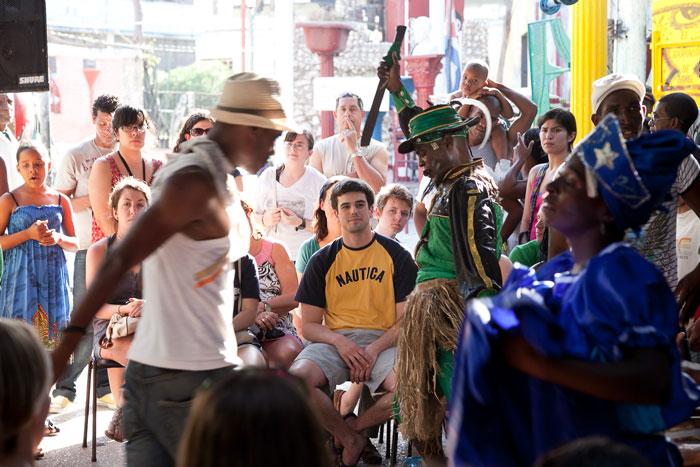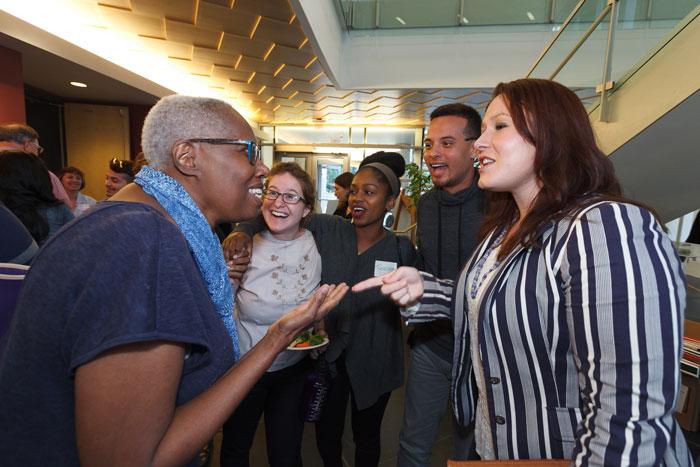Mosaic Memories

Built to challenge students to delve into the lives of people and communities and to actively listen to the voices that emerge, the Mosaics offer new perspectives and plentiful opportunities for self-reflection. Seen here, students immerse themselves in the local culture as part of the 2012 Cuba Mosaic. Photo by Carl Socolow ’77.
Mosaic program celebrates 20th anniversary, and students and faculty share memories
Dickinson’s Mosaics are intensive, interdisciplinary research programs that have been immersing students and faculty members into diverse domestic and global communities for 20 years. The program began locally but has long since found students and faculty exploring communities in such countries as Argentina, Peru, Morocco, South Africa, Ghana, Denmark and Mexico. Here is a sampling of two decades of experiences—as diverse as the people encountered along the way—explored through participants’ own words.
Susan Rose ’77, Charles A. Dana Professor of Sociology, director of the Community Studies Center: I've been directly involved in around a dozen Mosaics. Chuck Barone (economics), Sharon O’Brien (American studies) and I organized the first one in Steelton, Pa., in spring 1996. We were interested in examining the impact of deindustrialization on this multiethnic community and working with elementary and secondary students to explore their own town and its history. Dickinson had strong global programs, but we thought it was important to engage students in meaningful ways with domestic diversity as well, so that was clearly the focus. And then it was all about, “How do we get our students engaged with neighbors living around us and with communities nearby, and how are global forces and local conditions and lives connected?”
Becci Menghini ’96 (Steelton, 1996): I remember the first time I walked into the steel mill. It was not until we listened to second- and third-generation steel workers tell us about losing everything they’d known that I understood just how interconnected the world is. I have since come to understand that the lessons of that semester extended well beyond any grade or paper—my world had been opened up by people whose lives were so different from mine.

Joyce Bylander, left, vice president and dean of student life, engages students and alumni at the reception celebrating the Mosaic program's 20th anniversary, which occurred during Homecoming & Family Weekend in late September. Photo by Carl Socolow '77.
Jamie Metzinger Shover ’98 (Steelton, 1996): [The Mosaic] ended up steering my whole college career and allowed me to mature as a college student. The knowledge I gained as a part of the Mosaic gave me a confidence in my own abilities as a student and a voice as a young woman with a valuable perspective to share. From that point forward, I was a confident student; I felt my studies mattered, and I felt like I belonged.
Natalie Vinski ’00 (Mexican Migration Mosaic, 1998): My Mosaic memories are still clear: a beautiful autumn spent exploring the winding back lanes of Adams County, learning about life, language and music from Mexican-born farm workers. The Mosaic triggered in me a now long-standing personal, professional and academic interest in international education and cross-cultural research and helped me develop the skills and qualities I need to succeed as an internationally minded educator in our globalized world.
Marcelo Borges, professor of history: I have participated in several Mosaics, starting with the first Patagonia Mosaic in 2001. The initial inspiration came as a result of the Steelton Mosaic, and there were interesting parallels between Steelton and the oil towns of Patagonia that we studied. The sense of collaboration and exploration shared by students, faculty and people from many communities around the world are central to these experiences. And the rewards of learning from so many people and adding an important human dimension to our understanding of historical and contemporary experiences keep me coming back for more.
Lisa Wheeler ’03 (Steelton Mosaic, 2001): The people of Steelton let us share in their lives for a few months and always made us feel welcome. I worked with the kids at the Boys and Girls Club, and they were so full of life and energy and loved sharing their town with us. It taught us how to connect with those people and let them know that their lives matter. In this day and age, I think that's a far better skill to have than almost any other "schooling" you can receive.
Lauren Ashley Smith ’06 (Mexican Migration Mosaic, 2003): Our entire group was graciously invited [to a wedding reception], and it was such a once-in-a-lifetime experience to witness the cultural traditions and personal moments of the family and the community in Peribán. There is nothing like seeing, living, feeling, tasting and experiencing the world you are trying to understand in your work. The experience deepened my understanding of all of the reading and research I did. It was an unparalleled academic experience.
Neil Leary, director of the Center for Sustainability Education: Watching Kelly Rogers ’10 the first morning of the Copenhagen, Denmark, conference (2009) use a chance meeting with Jonathan Pershing, senior U.S. climate negotiator, to confidently and expertly conduct our team's first interview was amazing. Meeting Tom Goldtooth, a Native American environmental leader, at a conference in Washington a month after the Lima, Peru, conference (2014) is another great memory. After sharing a bit of information about each other, we smiled and simultaneously said “Joe Riley.” Joe ’17, a student in the Lima Mosaic, had interviewed Tom for his research project on indigenous peoples’ rights and climate change and had made a positive impression on Tom.
Orli Segal ’15 (Mediterranean Migration Mosaic, 2013): After spending several days in Rabat, Morocco, we all packed up the van to travel to northern Morocco. We were surprised when the trip was interrupted by a pit stop—not your typical rest stop. Little did we know, we were about to spend the next couple of hours in the Moroccan Parliament meeting with officials. The members of the Parliament were interested in our work, and everyone was able to share knowledge and emerge with a greater understanding. Learning experiences and general research were often conducted in the moment—through getting to know the city and people by whom we were surrounded.
Justin McCarty ’15 (Climate Change Mosaic, 2014). A really superb education, in my opinion, is one that isn't exactly focused on solving problems; it’s one that leads the student to a greater understanding of the issue at hand. I believe that this is the education Dickinson wants for us, and the Climate Change Mosaic definitely delivered it. The intentionality of the Mosaics also bonds groups together like nothing I have ever experienced before. So with those two things—an incredible moment of education and the creation of a lifelong group of colleagues and friends—I think that there is no equal to a Dickinson Mosaic.
Susan Rose: It’s not just students doing a field trip or students just listening to talks—it’s thinking about what they’re learning as a gift from the community, those narrative truths. It’s not only what they gain in terms of raising important questions and gaining various research and analytical skills but also how they give back to the communities with whom they have been working. This may come in the form of relationships and greater mutual understanding, and in terms of research papers or multimedia websites or documentaries. A lot of focus is on interviewing and oral histories, as well as archival, secondary and policy research, so for me it’s been about the conversations that take place, about engaging others in meaningful ways.
For more on the Mosaic program's 20th anniversary, keep an eye out for the Mosaics story in Dickinson Magazine.
Learn more
- Mosaics
- Reflections on the Mosaics
- Global Study & Engagement
- Take a look at the recent South Africa Race and Education Mosaic: Parallel Worlds
- Latest News
Published October 16, 2015